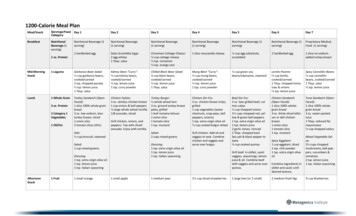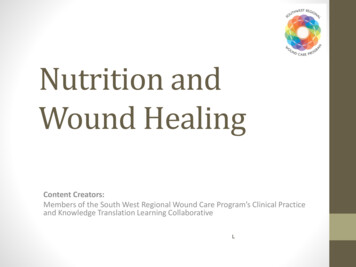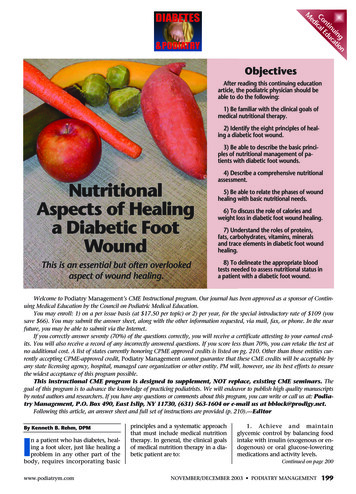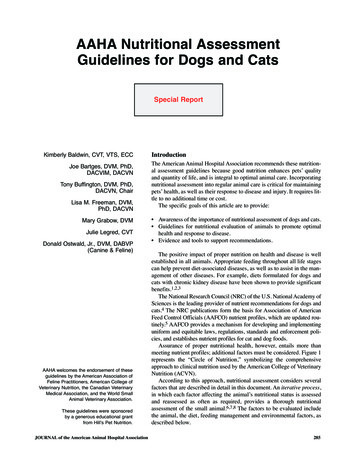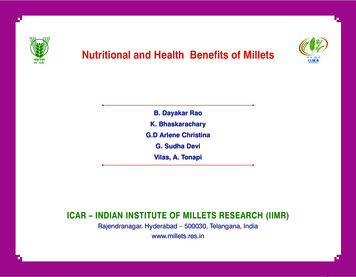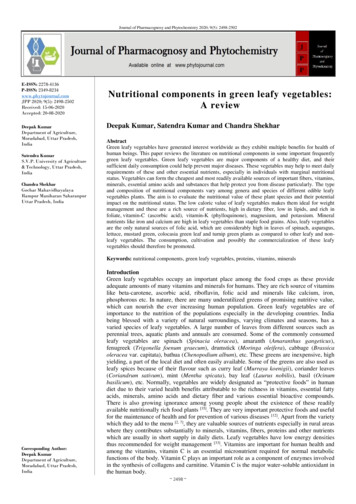
Transcription
Journal of Pharmacognosy and Phytochemistry 2020; 9(5): 2498-2502E-ISSN: 2278-4136P-ISSN: 2349-8234www.phytojournal.comJPP 2020; 9(5): 2498-2502Received: 15-06-2020Accepted: 20-08-2020Deepak KumarDepartment of Agriculture,Moradabad, Uttar Pradesh,IndiaSatendra KumarS.V.P. University of Agriculture& Technology, Uttar Pradesh,IndiaChandra ShekharGochar MahavidhayalayaRampur Maniharan SaharanpurUttar Pradesh, IndiaNutritional components in green leafy vegetables:A reviewDeepak Kumar, Satendra Kumar and Chandra ShekharAbstractGreen leafy vegetables have generated interest worldwide as they exhibit multiple benefits for health ofhuman beings. This paper reviews the literature on nutritional components in some important frequentlygreen leafy vegetables. Green leafy vegetables are major components of a healthy diet, and theirsufficient daily consumption could help prevent major diseases. These vegetables may help to meet dailyrequirements of these and other essential nutrients, especially in individuals with marginal nutritionalstatus. Vegetables can form the cheapest and most readily available sources of important fibers, vitamins,minerals, essential amino acids and substances that help protect you from disease particularly. The typeand composition of nutritional components vary among genera and species of different edible leafyvegetables plants. The aim is to evaluate the nutritional value of these plant species and their potentialimpact on the nutritional status. The low caloric value of leafy vegetables makes them ideal for weightmanagement and these are a rich source of nutrients, high in dietary fiber, low in lipids, and rich infoliate, vitamin C (ascorbic acid), vitamin K (phylloquinone), magnesium, and potassium. Mineralnutrients like iron and calcium are high in leafy vegetables than staple food grains. Also, leafy vegetablesare the only natural sources of folic acid, which are considerably high in leaves of spinach, asparagus,lettuce, mustard green, colocasia green leaf and turnip green plants as compared to other leafy and nonleafy vegetables. The consumption, cultivation and possibly the commercialization of these leafyvegetables should therefore be promoted.Keywords: nutritional components, green leafy vegetables, proteins, vitamins, mineralsCorresponding Author:Deepak KumarDepartment of Agriculture,Moradabad, Uttar Pradesh,IndiaIntroductionGreen leafy vegetables occupy an important place among the food crops as these provideadequate amounts of many vitamins and minerals for humans. They are rich source of vitaminslike beta-carotene, ascorbic acid, riboflavin, folic acid and minerals like calcium, iron,phosphorous etc. In nature, there are many underutilized greens of promising nutritive value,which can nourish the ever increasing human population. Green leafy vegetables are ofimportance to the nutrition of the populations especially in the developing countries. Indiabeing blessed with a variety of natural surroundings, varying climates and seasons, has avaried species of leafy vegetables. A large number of leaves from different sources such asperennial trees, aquatic plants and annuals are consumed. Some of the commonly consumedleafy vegetables are spinach (Spinacia oleracea), amaranth (Amaranthus gangeticus),fenugreek (Trigonella foenum graecum), drumstick (Moringa oleifera), cabbage (Brassicaoleracea var. capitata), bathua (Chenopodium album), etc. These greens are inexpensive, highyielding, a part of the local diet and often easily available. Some of the greens are also used asleafy spices because of their flavour such as curry leaf (Murraya koenigii), coriander leaves(Coriandrum sativum), mint (Mentha spicata), bay leaf (Laurus nobilis), basil (Ocinumbasilicum), etc. Normally, vegetables are widely designated as “protective foods” in humandiet due to their varied health benefits attributable to the richness in vitamins, essential fattyacids, minerals, amino acids and dietary fiber and various essential bioactive compounds.There is also growing ignorance among young people about the existence of these readilyavailable nutritionally rich food plants [35]. They are very important protective foods and usefulfor the maintenance of health and for prevention of various diseases [12]. Apart from the varietywhich they add to the menu [2, 7], they are valuable sources of nutrients especially in rural areaswhere they contributes substantially to minerals, vitamins, fibers, proteins and other nutrientswhich are usually in short supply in daily diets. Leafy vegetables have low energy densitiesthus recommended for weight management [33]. Vitamins are important for human health andamong the vitamins, vitamin C is an essential micronutrient required for normal metabolicfunctions of the body. Vitamin C plays an important role as a component of enzymes involvedin the synthesis of collagens and carnitine. Vitamin C is the major water-soluble antioxidant inthe human body. 2498
Journal of Pharmacognosy and Phytochemistryhttp://www.phytojournal.comGreen leafy vegetables contains numerous minerals such asiron (Fe), calcium (Ca), phosphorus (P), Copper (Cu), Zinc(Zn), Sodium (Na) and chloride (Cl) which have vital forgrowth, metabolism etc (table 1). The predominant elementsfound in green leafy vegetables are iron (Fe), calcium (Ca),potassium (K), sodium (Na) etc. Dark lettuces are rich invitamins A, C and K; eating them regularly will improve youreyesight, bone health and skin elasticity while helping yourblood to clot normally. Spinach is one of the most nutritiousfoods available, as it is low in calories and high in vitamins;spinach is one of the most nutrient-dense foods in existence. Itis packed with vitamins A and C, as well as foliate. Heatreduces the green’s oxalate content, freeing up its dietarycalcium [45], cooked spinach gives you more nutrition thanraw, but is excellent eaten raw in salads. These include healthpromoting plant secondary metabolites composed ofantioxidants and phenolic compounds. WHO/FAO (2003)published a report recommends minimum of 400g of fruit andvegetables per day (excluding potatoes and other starchytubers) for the prevention of chronic diseases such as heartdisease, cancer, diabetes and obesity, as well as for theprevention and alleviation of several micronutrientdeficiencies. The dietary guidelines for Americansrecommend five servings of vegetables per day based on anintake of 2000 calories (HHS/USDA, 2015). It is alsorecommended that one of the five servings of vegetablesshould be green leafy vegetables. Spinach and othergreen leafy vegetables are rich sources of foliate along withother vegetables, fruit, Brewer's yeast, legumes, andespecially liver[31, 32]. Nutritionists and dieticians are of theopinion that people should diversify their diets as no singlevegetable meets all the nutritional requirements necessary forgood health and wellbeing [3, 51]. Globally, crop diversity andnutritional value of vegetable crops are of special significancefor improving food and nutrition security [4, 32].Fresh green vegetables are also good sources of folic acid,which is required for the multiplication and maturation of redcells [18]. Cabbage is an excellent source of vitamin C andvitamin K, containing more than 20% of the daily value foreach of these nutrients per serving [5]. Cabbage is also a goodsource of dietary fiber, vitamin B 6 and folate, with no othernutrients having significant content per 100 gram serving.Dark green lettuces include romaine lettuce (Lactuca sativa L.var. longifolia), arugula or tara mira (Eruca vesicaria) andbutter head lettuce (Lactuca sativa var. capitata). Thesenutrient dense leaves are crisp and slightly bitter, and mostpeople use them to make raw salads [5, 47]. Plants are majorsources of numerous bioactive compounds collectively termedas phytochemicals, which are reported to be key to goodhealth [6, 15]. As such phytochemicals can be broadly classifiedas nutritional components (e.g., essential fatty acids, proteins,vitamins, minerals and phenolic compounds). Nowadays,underutilized foods are gaining importance as a means toincrease the per capita availability of foods [9, 16].Table 1: Nutritional composition of some green leafy vegetables (per 100 g edible portion)MacronutrientsVitaminsMineralsEnergy Moisture Protein Fat Carbohydrate Thiamine Riboflavin Niacin Ascorbic Calcium PhosphorusSpinach26.092.12.0 0.72.9030260500287321Coriander44.086.33.3 0.66.3506080013518471Mint leaves 48.084.94.8 0.65.85026010002720062Fenugreek49.086.14.4 0.96.0403108008239551Bathua30.089.63.7 0.42.9101406003515080Cabbage27.091.91.8 0.14.660904001243944Amaranth45.085.74.0 0.56.13030120099.039783Drumstick38.075.96.7 1.74.160508005244070Source: Gopalan et al., (2004).VegetablesNutritional components in green leafy vegetablesDietary fiberGreen leafy vegetables have been traditionally recognized asgood sources of dietary fiber [39]. There are epidemiologicalevidences that show that dietary fiber is important inpreventing several diseases, especially the fiber that is foundin leafy vegetables such as celery, cabbage, spinach andlettuce that is characterized by high water content and a highpercentage of fiber [12]. Fibre has also been found to lowercholesterol levels by reducing the reabsorption of cholesterolproduced by the body to help with the digestion of fat.Vegetables that belong to the cabbage family (cabbage,cauliflower, turnips and brussels sprouts) contain compoundsthat may be good at protecting against cancer. Vegetables thatare high in fibre are spinach and cabbage [36]. Literatureinformation showed that Indian green leafy vegetables such ascabbage, spinach, fenugreek, coriander and basella are goodsources of soluble dietary fiber content. Consumption ofhigher levels of vegetable fiber resulted keeps the digestivesystem healthy, helps healthy body weight and reduced risk ofcardiovascular diseases and possibly, colon cancer [36],[25]. Itwas more significant in resolving the problem of constipation,diabetes, diverticulitis and obesity e other leafy green vegetables, spinach contains a wealthof nutrients. Each half-cup of boiled spinach provides 573mcgof vitamin A, which is 229% of the daily value (DV).Some research indicates that spinach can lower bloodpressure and improve heart health. Fresh, young, leavescontain more vitamin C than mature plants. The green outerleaves of lettuce and cabbage are rich in vitamin, than whiteinner leaves. Thinner and greater leaves are more nutritiousand usually have lower calories. Carotenoids, like betacarotene, are found in plant foods and have to be converted bythe body into vitamin A [49]. Green leafy vegetables areabundant sources for beta-carotene. In leaves, vitamin-A ispresent in the form of provitamin-A carotenoids such as betacarotene (ca. 25-30%), alpha-carotene, beta-cryptoxanthin,gamma-carotene and non-provitamin A carotenoids lutein (ca.45%), violaxanthin (ca. 15%) and neoxanthin (ca. 15%),[40]the content of vitamin-A is expressed in retinol equivalents(RE) with one (1) RE being equivalent to 6µg of betacarotene and 12µg of the other pro vitamincarotenoids. Processing techniques such as cooking, boiling,and steaming have significant influence on availability ofcarotenoids content in green leafy vegetables [40]. A studyconducted on 30 commonly used green leafy vegetables for 2499
Journal of Pharmacognosy and al purposes confirm the presence of good amount oflutein [37] and richness in various vitamins. For instance, anyspecies of Amaranths are excellent source of vitamin-C[26].Moreover, comparisons can be made on vitaminsdistribution among seeds and leafy plants.For instance, data obtained from USDA national nutrientdatabase [50, 52], clearly shows that vitamin A and K1(Phylloquinone) in leafy vegetables are exceptionally high forkale and spinach than the cereals and pulses. Vitamin E induck weed (45.7mg/100g) is high among many common leafyvegetables and seeds. Foliate is a water-soluble compound,which belongs to vitamin B (B 9) group. Deficiency of folicacid has severe metabolic and clinical consequences. Plantsare the major source of foliates for humans especially, greenleafy vegetables [31]. Cereal grains and tuber based staple dietare very low in foliate, which can be improved by the additionof green leafy vegetables. Leaves of colocasia (Colocasiaesculenta) are used as an excellent source of foliate in theIndian diet. However, it is noticed that about 50% or more offoliate in food is found to be destroyed during cooking. Thisis mainly attributed to prolonged heating of vegetables in alarge volume of water. Hence, it is advisable to consume thewater used during the cooking of vegetables [30]. Highperformance liquid chromatography i.e. HPLC–DAD–MS/MS based method developed by Santos et al. [46] allows asimple and sequential extraction and monitoring of severalfree forms of water soluble vitamins (vitamins B 1, B 2, B 3,B 5, B 6, B 9 and C) and fat-soluble vitamins (pro-vitamin Aandvitamin E)presentinrawgreenleafyvegetables (Table 2).Table 2: Vitamins composition for some green leafy vegetablesVitamins concentrationsVitamin A, IUVitamin B1, mgVitamin B2, mgVitamin B5, mgVitamin B6, mgVitamin C, mgVitamin E, mgVitamin K1, mgSource: (Edelman and Colt, 2016) ,5000.91.80.91.825618.24400Proteins:Green leafy vegetables are the richest and cheapest sources ofproteins. Protein nutritional quality is determined by theproportions of essential amino acids, which cannot besynthesized by humans and hence must be provided in thediet. If only one of these amino acids is limiting, the otherswill be broken down and excreted, resulting in poor growth oflivestock and humans and loss of nitrogen in the diet. Tenamino acids are strictly essential: lysine, isoleucine, leucine,phenylalanine, tyrosine, threonine, tryptophan, valine,histidine and methionine, all of which are present in C. album[21]. Green matter of C. album is a valuable high-proteinproduct [27], which is another argument in favour ofcultivation of this species. Proteins play critical roles incellular functions, structure and regulations of metabolicactivities in all living organisms. Hence, proteins haveprimary importance in the daily diets of consumers. This isbecause of their ability to synthesize and accumulative aminoacids with the help of abundant source of sunlight, water,oxygen and nitrogen which is readily available in theatmosphere. Protein nutritional quality is determined by theproportions of essential amino acids, which cannot besynthesized by humans and hence must be provided in the diet[1]. If only one of these amino acids is limiting, the others willbe broken down and excreted, resulting in poor growth oflivestock and humans and loss of nitrogen in the diet. Proteinsare large and complex molecules composed of variouscompositions of amino acids. About 50% of total leaf cellprotein is dominatedby ribulose-1,5-bisphosphatecarboxylase/oxygenase (RUBISCO), which can be found inleaf chloroplasts.It plays a vital role in the fixation of atmospheric carbonduring photosynthesis [28]. RUBISCO is a similar proteinfound in all green leafy vegetables with few changes in aminoacid groups from species to species. Recent evidence showedthat green leafy vegetables such as spinach (Spinaciaoleracea), broccoli (Brassica oleracea var. Italic) andduckweed (Lemna perpusilla) provide all the essential aminoacids that meet the FAO nutrition standards [9]. Evidenceshowed that apart from lower methionine content,cassava (Manihot esculenta) leaves consumed as green leafyvegetable has amino acids profile comparable with pulse anddairy products [14]. It has been found that some of the leafyvegetables such as green leaves of septic weed (Sennaoccidentalis) and cassava (Manihot esculenta) both have 7gprotein/100g of fresh weight. This is higher than that of exoticleafy vegetables such as cabbage (Brassica oleracea Capitate)with a protein content of 1 g/100 g of fresh weight [50]. Theamount of protein content in leafy vegetables can vary withfarming practices and prevailing environmental conditions [34].MineralsThis group includes spinach, lettuce, curly lettuce, chard,chicory etc. these are important minerals (iron and calcium),Vitamins (A, B 2, & C) and fiber sources. This serving alsoprovides 17% of the DV for iron and 20% of the DVfor magnesium. Magnesium plays a role in over 300 processesin the human body. Vitamin K-1 (phylloquinone), present ingreen, leafy vegetables and some other plant sources. Thezinc content of C. album compares favourably to most valuesfor green leafy vegetables reported in the literature [22]. Zinc isinvolved in normal functioning of immune system. Shahi(1977) conducted field studies for 2 years which revealed thatC. album contained very high degree of N, P, K, Ca, Mg, Feand Mn. Its nutrient content declined with advancement in ageof the plant. Guerrero and Isasa (1997) reported high mineralcontents than in other green leafy vegetables.WHO (1996) stated that the overall malnutrition must nolonger be considered without reference to micronutrientstatus, as the two are inextricably linked. Attempting onutrient deficiencies will not result in optimal growthand function [4]. Metal ions are important to the normalfunctioning and wellbeing of humankind as they serve ascofactors in enzymatic reactions and maintain proteinstructures. Iron deficiency in women and children lead to thedevelopment of anemia [17]. Zinc deficiency is results inimpaired gastro intestinal and immune functions [33, 49]. Acomparative mineral profile for seeds and green leaves arepresented in Table-2. The data shows that green leafyvegetables are good sources of mineral nutrients. For instance,spinach has highest amount of calcium (1036mg/100g),magnesium (827mg/100g), iron (28.4mg/100g) and sodium(827mg/100g) whereas duck weed is high in zinc(15mg/100g). Minerals have greater stability during foodprocessing as compared to vitamins and proteins [30]. 2500
Journal of Pharmacognosy and Phytochemistryhttp://www.phytojournal.comTable 3: Minerals composition of some green leafy vegetables(mg per 100 g)diseases emerging from malnutrition. The present study hasshown that the leafy vegetables have high content of moisture.The low fat content of all green leafy vegetables is inagreement with the general observation that leafy vegetablesare low in lipids. The results suggest that the vegetables ifconsumed in sufficient amount would contribute greatlytowards meeting the nutritional requirement for normalgrowth and also could provide adequate protection againstdiseases arising from malnutrition.Green Leafy .328.4Zinc3.2 Source: (Edelman and Colt, 2016).MineralsEssential fatty acidsOmega 3 is an important nutrient, which is not produced byour body and that is why we need to take it orally. It is anextremely beneficial compound as it offers multiple healthbenefits. Some health benefits are: it reduces the risk of heartdisease, improves brain function, improves memory, regulatesblood pressure and control diabetes [8, 20]. Omega 3 fatty acidsare important for normal growth and development, and playvital role in the prevention and treatment of coronary arterydiseases, hypertension, diabetes, arthritis, cancer and otherinflammatory and autoimmune disorders [22], alpha linolenicacid, the precursor of omega 3 fatty acid has been found ingreen leafy vegetables with beneficial effects on health. It isknown that essential fatty acids help to control variouschronic diseases [42]. Evidence shows that omega 3 fatty acidsis relatively high in wild plants than in cultivated vegetables[19, 20]. The same study also reported the presence ofalpha linolenic acid in other leafy green vegetables such as1.7 mg/g in spinach, 1.1mg/g in mustard greens, 0.7 mg/g inred leaf lettuce and 0.6 mg/g in butter crunch lettuce [22]. Fattyacids in leaves can be determined by gas chromatography [47].Spinach helps to improve the brain function, memory, lowerthe risk of heart problems, regulates blood pressure and boostsour energy. Spinach is also rich in Omega 3 fatty acid. 100 gof spinach contains 370 mgs of omega 3.ConclusionGreen leafy vegetables provide vital nutrients required forhuman health and wellbeing. Being rich in essentialmicronutrients the green leafy vegetables can be utilized forthe purpose of enrichment of nutritional deficient products.These include dietary fiber, vitamins, essential fatty acids,minerals and amino acids etc. In rural areas, traditional leafyvegetables play important role as nutritional source, and it isavailable round the year. It also has significant socioeconomicbenefits. Green leafy vegetables are usually considered as thecheapest source of food for vitamins and micronutrientssupplementation to conflict nutrients deficiencies. It is alsoused as herbal and medicinal plants in various cultural andtraditional settings for many different ailments. There is ascope for research to identify and explore the potential ofedible leaves of indigenous and under-exploited plants for useas food and medicine, and inclusion in mainstream agri-foodsystems. Research is also needed to explore different varietiesand possibility of adopting agronomic practices in green leafyvegetables and enhance their nutritive value. The Thermalprocessing of leafy vegetables through boiling, cooking andblanching before consumption help in reducing the level ofanti-nutrients. The results suggest that the vegetables ifconsumed in sufficient amount would contribute greatlytowards meeting the nutritional requirement for normalgrowth and also could provide adequate protection againstReferences1. Aletor O, Oshodi A, Ipinmoroti K. Chemical compositionof common leafy vegetables and functional properties oftheir leaf protein concentrates. Food Chemistry. 2002;78(1):63-68.2. Asaolu SS, Adefemi OS, Oyakilome IG, Ajibulu KE,Asaolu MF. Proximate and Mineral Composition ofNigerian Leafy Vegetables. Journal of Food Research.2012; 1(3):214-218.3. Britton G. Carotenoids. In: Hendry GAF, et al, editors.Natural food colorants, Springer, USA, 1996, 197-243.4. Baudoin WO, Louise Fresco O. Food and nutritionsecurity towards human security. ICV Souvenir Paper,Italy, 2002, 1-19.5. Colonna E, Rouphael Y, Barbieri G et al., Nutritionalquality of ten leafy vegetables harvested at two lightintensities. Food Chem. 2016; 199:702-710.6. Dias JS, Major classes of phytonutriceuticals invegetables and health benefits: A review. Journal ofNutritional Therapeutics. 2012; 1(1):31-62.7. Dietary Guidelines for Americans 2015–2020. 8th ed.USA; 2015, 1-144.8. Da Silva Dias Joao Carlos, Imai S. Vegetablesconsumption and its benefits on diabetes. Journal ofNutritional Therapeutics. 2017; 6(1):1-10.9. Edelman M, Colt M. Nutrient value of leaf vs.seed. Front Chem. 2016; 4:1-32.10. FAO W. Human vitamin and mineral requirementsReport of a Joint FAO/WHO Expert Consultation,Bangkok, Thailand. Food and Nutrition Division, FAO,Rome, Italy, 2001, 1-303.11. Fathima Begum K, Rajalakshmi D. “Microwave Dryingof selected greens and their sensory characteristics,”Plant food for human nutrition. 2001; 56:303-311.12. Fresco Louisce O, Baudoin Wilfried O. Food andNutrition Security towards Human Security, FoodSecurity and Vegetables–A Global Perspective, P.N.Agricultural Science Foundation, Bangalore, India, 2004,7-42.13. Judith Shaber t K. in Encyclopedia of Gastroenterology,2004.14. Fasuyi AO. Nutrient composition and processing effectson cassava leaf (Manihot esculenta crantz) antinutrients. Pakistan Journal of Nutrition. 2005; 4(1):37-42.15. Grusak MA, Della Penna D. Improving the nutrientcomposition of plants to enhance human nutrition andhealth. Annu Rev Plant Physiol Plant Mol Biol. 1999;50(1):133-161.16. Gopalan C, Ramasastri B, Balasubramanian S. Proximateprinciples: Common foods. Nutritive Value of IndianFoods (Revised and Updated Edition). Hyderabad, India:National Institute of Nutrition, ICMR, India, 2000, 53-55.17. Galloway R. Anemia prevention and control: What workspart I: Program guidance, USA, 2003, 1-77. 2501
Journal of Pharmacognosy and Phytochemistryhttp://www.phytojournal.com18. Gopalan C, Sastri R, Balasubramanian SC. Nutritivevalue of Indian foods. National Institute of Nutrition,ICMR, Hyderabad, 2004, 52.19. Gibson RS, Perlas L, Hotz C. Improving thebioavailability of nutrients in plant foods at the householdlevel. Proc Nutr Soc. 2006; 65(2):160-168.20. Guil Guerrero JL, Torija Isasa ME. Fatty acid profiles ofMediterranean wild edible plants. In: Sánchez Mata M, etal, editors. Mediterranean wild edible plants, Springer,USA, 2016, 173-186.21. Guerrero JLG, Isasa MET. Nutritional composition ofleavesof Chenopodium species(C.album L., C.murale L. and C. opulifolium. Int J Food Sci Nut. 1922. Hamazaki T, Okuyama H. Fatty acids and lipids–Newfindings. Karger Medical and Scientific Publishers,Japan, 2001, 1-53.23. Hassan LG, Umar KJ. Nutritional value of Balsam apple(Momordica balsamina L.) leaves. Pakistan Journal ofNutrition. 2006; 5:522-529.24. Iheshiulo EM, Abbey L, Asiedu SK. Response of kale tosingle–dose application of K humate, dry vermicasts, andvolcanic minerals. International Journal of VegetableScience. 2017; 23(2):135-144.25. Jenkins DJ, Kendall CW, Popovich DG et al., Effect of avery–high–fiber vegetable, fruit, and nut diet on serumlipids and Colonic function. Metabolism. 2001;50(4):494-503.26. Jiménez Aguilar DM, Grusak MA. Minerals, vitamin C,phenolics, flavonoids and antioxidant activity ofAmaranthus leafy vegetables. Journal of FoodComposition and Analysis. 2017; 58:33-39.27. Jacobsen SE. The worldwide potential of quinoa(Chenopodium quinoa Willd) Food Rev Int. 2003;19:167-177. doi: 10.1081/FRI-120018883.28. Kawashima Nobumaro, Wildman SG. Fraction Iprotein. Annual Review of Plant Physiology. 1970;21(1):325-358.29. Kumari M, Gupta S, Lakshmi AJ et al., Ironbioavailability in green leafy vegetables cooked indifferent utensils. Food Chemistry. 2004; 86(2):217-222.30. Kala A, Prakash J. Nutrient composition and les. International Journal of Food Properties.2004; 7(3):659-669.31. Moll R, Davis B., Iron, vitamin B 12 and folate.Medicine. 2017; 45(4):198-203.32. National Research council. Recommended dietaryallowances USA: National Academy Press, 1989, 1-285.33. Nath P, Gaddagimath PB, Dutta O. Food and nutritionsecurity and vegetables: A Global Perspective. PremNath Agricultural Science Foundation, India, 2004, 1412.34. Nwanekezie EC, Obiakor-Okeke PN. Mineral Content ofFive Tropical Leafy Vegetables and Effect of HoldingMethods and Time. American Journal of ExperimentalAgriculture. 2014; 4(12):1708-1717.35. Odhav B, Beekrum S, Akula U et al., Preliminaryassessment of nutritional value of traditional leafyvegetables in KwaZulu–Natal, South Africa. Journal ofFood Composition and Analysis. 2007; 20(5):430-435.36. Otles S, Ozgoz S. Health effects of dietary fiber. ActaScientiarum Polonorum Technologia Alimentaria. 2014;13(2):191-202.37. Office Of Dietary Supplements Fact Sheet: Vitamin A38. Joshi P, Mathur B. “Preparation of value added productsfrom the leaf powders of dehydrated less utilized greenleafy vegetables” Journal of horticulture and forestryvolume. 2010; 2(9):223-228.39. Roberfroid M. Dietary fiber, inulin, and oligofructose: Areview comparing their physiological effects. Crit RevFood Sci. Nutr. 1993; 33(2):103-148.40. Raju M, Varakumar S, Lakshminarayana R et al.Carotenoid composition and vitamin A activity ofmedicinally important green leafy vegetables. FoodChemistry. 2007; 101(4):1598-1605.41. Shahi HN. Studies on chemical compositionof Chenopodium album L. Plant Soil. 1977; 46:271-273.42. Simopoulos AP. Omega‐3 fatty acids in wild plants, nutsand seeds. Asia Pacific Journal of Clinical Nutrition.2002; 11(s6):S163-S173.43. Salunkhe DK, Kadam SS. Handbook of vegetable scienceand technology: production, composition, storage andprocessing. Marcel Dekker (Ed.), New York, 1998.44. Spiller G. Dietary fiber in prevention and treatment ofdisease. CRC Handbook of Dietary Fiber in HumanNutrition. USA: CRC Press LLC, 2001, 363-431.45. Sa’eed MD, Abdullahi MR. Calcium and Iron Levels inSome Fruits and Vegetables Commonly Consumed inKano Metropolis, Nigeria. Bayero Journal of Pure andApplied Sciences. 2012; 5:57-59.46. Santos J, Mendiola J, Oliveira M et al., Sequentialdetermination of fat–and water–soluble vitamins in greenleafy vegetables during storage. J Chromatogr A. 2012;1261:179-188.47. Shukla P, Kumar R, Raib AK. Detection of minerals ingreen leafy vegetables using laser induced breakdownspectroscopy. Journal of Applied Spectroscopy. 2016;83(5):872-877.48. Saini R, Manoj P, Shetty N et al., Relative bioavailabilityof folate from the traditional food plant Moringa oleiferaL. as evaluated in a rat model. J Food Sci Technol. 2016;53(1):511-520.49. Trumbo P, Yates AA, Schlicker S et al., Dietaryreference intakes: Vitamin A, vitamin K, arsenic, enum, nickel, silicon, vanadium, and zinc. J AmDiet Assoc. 2001; 101(3):294-301.50. US Department of Agriculture and US Department ofHealth and Human Services Dietary Guidelines forAmericans, 2010.51. Uusiku NP, Oelofse A, Duodu KG et al. Nutritionalvalue of leafy vegetables of sub–Saharan Africa and theirpotential contribution to human health:A review. Journalof Food Composition and Analysis. 2010; 23(6):499-509.52. US Department of Agriculture USDA Database Table forRaw Cabbage, 100 g. National Nutrient Database forStandard Reference, Version SR-27, 2014.53. WHO, FAO. Launched report in, 2003. 2502
foods available, as it is low in calories and high in vitamins; spinach is one of the most nutrient-dense foods in existence. It is packed with vitamins A and C, as well as foliate. Heat reduces the green's oxalate content, freeing up its dietary calcium [45], cooked spinach gives you more nutrition than
